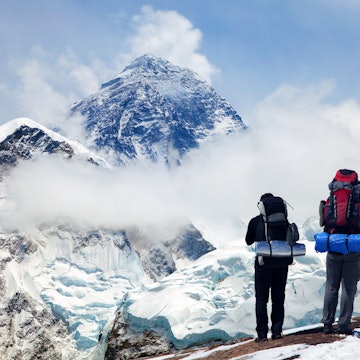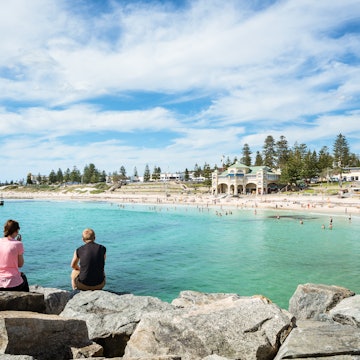
Australia Day: the birth of a modern nation or a symbol of invasion and survival?
Jan 25, 2021 • 5 min read

Rachael Hocking offers her views on Australia Day © Anadolu Agency/Getty Images
The story of Australia did not begin on January 26, 232 years ago, writes Warlpiri woman and NITV Indigenous affairs reporter Rachael Hocking, rather it goes back 60 million years and some 21 million sunsets.
By the end of this week, I will have lived through twenty-seven January 26s: a date contentiously dubbed Australia Day.

The actual events of that day in 1788 – when Governor Arthur Phillip raised the British flag at a place now known as Sydney Cove – have become the symbol of invasion and survival for many First Nations people. For others, the anniversary is celebrated as the birth of modern Australia.
My first January 26 was in 1994 – coincidentally this was also the first time the Australian Government officially regarded the date as the country’s “national day”. As a Warlpiri woman and Indigenous affairs reporter growing up with Australia Day, I have witnessed a transformation of this country’s collective memory.
As a student in the 90s and early 2000s January 26 was gaining traction in schools as “our” national day. Students were taught how many stars were in the Southern Cross, but not that this ancient constellation was a map that has guided my ancestors for millennia.

We were learning about the ANZACs and performing our own re-enactments of the First Fleet, but these lessons conveniently left out stories of Indigenous resistance. We were told the first wars this country fought were on behalf of the Crown, and that none occurred on the soil beneath our own feet. We were told about Captain James Cook (who was, in fact, a lieutenant), but not about our first diplomats and warriors: Bennelong, Pemulwuy, Barangaroo.
Despite the fact that the First Fleet didn’t arrive on January 26, Sydney has hosted re-enactments and, for the past century, annual “tall ship” regattas to mark the day. In 1938, the city decided to re-enact Phillip’s landing by bringing in Aboriginal men from a regional town and locking them up at the police barracks stables. They were brought out to play the role of “natives retreating before the might of the British musket”.
On that same day, one of the earliest recorded Aboriginal protests took place. The group argued that rather than a day of celebration, the 150th anniversary of colonisation was “A Day of Mourning”. They sought justice in the form of equal citizenship rights.
The bicentenary was the next big anniversary. As 1988 celebrations were in full swing, Sydney also played host to the “largest protest since the Vietnam moratorium”. The calls were for land rights and a re-telling of 1788 from a First Nations perspective: they called it Invasion.
In my early years, January 26 was spent on the road in countless different parts of the continent. Some were spent on my grandfather’s traditional Warlpiri country, south-west of Katherine on an outstation called Parnta. A few were on Larrakia country in that beautiful northern place where modern-day Darwin Harbour opens up to the Timor Sea.
I’ve spent many on Kulin land in the city now known as Melbourne, and where in 2018, we saw the country’s largest Invasion Day protests to date.

And I’ve seen First Nations people respond by inviting the country to learn more about our complex and diverse cultures, while simultaneously holding it accountable. I’ve seen non-Indigenous people genuinely seeking to understand.
For the past few years, I’ve spent the date as a visitor on Gadigal land: home to the Sydney Harbour Bridge and its neighbouring Opera House.
As a reporter for the country’s national Indigenous broadcaster, my day begins in the quiet moments before dawn. Here we remember the wars and massacres that took our people and country in the 1800s, and well into the last century.
Later, I interview protestors who use mega-phones calling for reparations and who shout with pride: “Always Was, Always Will Be Aboriginal Land”. In recent years, they have begun carrying posters with images of those who have died at the hands of the state.
I attend Survival Day festivals that celebrate Indigenous cultures: their resilience and existence despite attempts to eradicate languages, steal children, and conquer land.
I speak to many people whose relationship to January 26 does not mirror the Crocodile Dundee-style advertisements you might see at the Super Bowl.

As a Warlpiri woman from the central desert, I have my own fraught relationship with the date. Years ago, in my final year of university, I described that feeling as “isolation”. Years later, I’d now probably call it something like responsibility.
The full history of this continent has still not been accepted by many people who call this place Australia. It is why calls for a Truth and Justice Commission are getting louder. This is something many First Nations people have been actively involved in their whole lives: it is the act of speaking the language name for the country you are on, sharing the stories of warriors not commemorated by statues but passed down by our Elders orally.
The truth is the story of this continent did not begin 232 years ago with January 26, or when a lieutenant sailed along the coast in 1770: it goes back more than 60 thousand years and some 21 million sunsets. Until this country comes to terms with that history, and the trauma that followed, then there will be many people who refuse to participate in this country’s so-called Australia Day.
This article was originally published in January 2020 and updated in January 2021.













